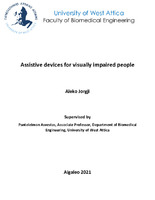Assistive devices for visually impaired people
Συστήματα παροχής βοήθειας για άτομα με προβλήματα όρασης

Λέξεις-κλειδιά
Visual impairment ; Assistive technologies ; Mobility aid ; Home assistance ; Obstacle detection ; Ultrasounds ; Voice commands ; Remote controlΠερίληψη
This thesis marks an attempt to better fathom the magnitude of visual impairment as a health issue, the needs of affected individuals, the available assistive technologies and also tries to provide an insight into the development of two affordable and reliable assistive systems for visually impaired people.
Despite the enormous efforts in designing reliable and user-friendly assistive devices for the visually impaired people there is plenty of room for improvement as usually these devices are bulky, complex in operation, expensive and in some cases fail to attain the initial claims by manufactures and researchers, leading to disappointment and frustration among the visually impaired people.
In an effort to address these issues and to provide a helping hand to this vulnerable part of society, we developed two assistive devices. The first is a mobility aid device that is wearable in form of a wrist or hand mounded glove embedded with two ultrasonic sensors that aim at identifying potential obstacles. When obstacles are identified the user is notified by beeping sounds of high or low intensity. The high intensity sound is activated when the identified obstacles are positioned at head level whereas the low intensity sound is triggered for obstacles that are positioned from ground to chest level. The second device is a home assistance system that enables visually impaired people to remotely control through voice commands lights, cooling system or any other household appliance. In addition, this systems is able to notify the user through voice messages about the detection of fire, the overcoming of specific limit in temperature and in which room has entered.
The gathered result from the testing of the systems indicate that the majority of the initially set goals are successfully accomplished. Testing of mobility aid system confirmed the fact that is intuitive in use, less obstructive, lightweight and user-friendly. As a shortcoming was identified the difficulty in detection of small objects and those that are at ground level. Regarding the testing of home assistance system, it was observed that its performance satisfies all the initially set objectives as the utilized sensors have a fast response, voice messages are generated correctly and under low noise environment the control of home appliances is attained easily.
Lastly, we acknowledge the fact that the proposed systems are far from the optimal solution for the visually impaired people and thus future enchantments are planned to be implemented. However, we believe that they have the potential to make a beneficial contribution in the lives of visually impaired people as their designs were based on a thorough examination of the strengths and weaknesses of past works and understanding of visually impaired people’s needs.

